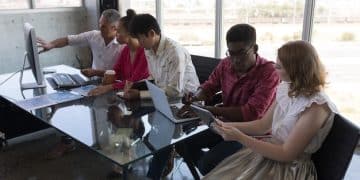Improve Team Communication: Insider Tips for Business Management

Improving team communication is crucial for effective business management, fostering collaboration, boosting productivity, and ensuring everyone is aligned towards common goals; this article provides insider tips to achieve seamless communication.
In today’s fast-paced business environment, **improve team communication: insider tips for effective business management** is no longer a luxury; it’s a necessity. When everyone moves in sync, that’s how you make results!
Why Effective Team Communication Matters
Effective team communication is more than just exchanging information; it’s the bedrock of a successful business. When communication flows smoothly, teams are more productive, innovative, and resilient.
Strong communication skills enhance collaboration, as team members can easily share ideas, provide feedback, and work together towards common goals. This, in turn, fosters a positive work environment where employees feel valued and motivated.

The Impact on Productivity
One of the most immediate benefits of effective team communication is increased productivity. When team members can quickly and clearly communicate their needs, expectations, and progress, workflow bottlenecks are reduced.
Building Trust and Transparency
Open and honest communication builds trust among team members and leadership. Transparency helps create a sense of ownership and accountability, ensuring everyone is invested in the company’s success.
- Clear Expectations: Define roles and responsibilities clearly to avoid misunderstandings.
- Feedback Culture: Encourage regular feedback to promote continuous improvement.
- Active Listening: Teach team members to listen actively to understand each other’s perspectives.
Ultimately, effective team communication transforms a group of individuals into a cohesive, high-performing unit, driving business success through streamlined processes and enhanced collaboration.
Setting the Stage: Communication Foundations
Before diving into specific communication techniques, it’s essential to establish a solid foundation. This involves creating a communication plan and choosing the right tools to facilitate seamless information exchange.
A well-defined communication plan outlines how, when, and why communication should occur within the team. This ensures that important information reaches the right people at the right time, minimizing confusion and delays.
Developing a Communication Plan
The first step in setting the stage for effective communication is drafting a comprehensive communication plan. This plan should address various aspects of team communication, including meeting schedules, reporting procedures, and conflict resolution strategies.
Choosing the Right Communication Tools
Selecting the appropriate communication tools is crucial for facilitating efficient and effective information sharing. The right tools can streamline workflows, improve collaboration, and enhance overall team productivity.
- Collaboration Platforms: Utilize tools like Slack or Microsoft Teams for instant messaging and file sharing.
- Project Management Software: Implement software like Asana or Trello to track tasks and project progress.
- Video Conferencing: Use Zoom or Google Meet for virtual meetings and remote collaboration.
By laying these foundations, you create an environment where effective communication can thrive, enabling your team to work together more efficiently and achieve better results.
Mastering the Art of Active Listening
Active listening is a cornerstone of effective communication. It involves fully concentrating on what the other person is saying, understanding their message, and responding thoughtfully. It promotes empathy and mutual understanding.
When team members practice active listening, they not only understand the information being conveyed but also the emotions and intentions behind it. This deeper understanding fosters trust and strengthens relationships within the team.

Techniques for Active Listening
Mastering the art of active listening requires practice and a conscious effort to engage fully in the conversation. Here are some techniques to help you and your team become better listeners:
Overcoming Listening Barriers
Even with the best intentions, various barriers can hinder effective listening. Recognizing and addressing these barriers is essential for improving communication.
- Minimize Distractions: Create a quiet environment free from interruptions.
- Avoid Interrupting: Let the speaker finish their thoughts before responding.
- Stay Present: Focus on the speaker and avoid thinking about your response prematurely.
By mastering the art of active listening, team members can build stronger relationships, improve collaboration, and enhance overall communication effectiveness, leading to better business outcomes.
Giving and Receiving Feedback Effectively
Feedback is essential for growth and development. Learning how to give and receive feedback constructively is vital for fostering a culture of continuous improvement within the team. It helps individuals understand their strengths and areas for improvement.
Constructive feedback not only highlights areas where improvements are needed but also acknowledges and reinforces successes. This balanced approach encourages team members to strive for excellence while feeling supported and valued.
The Sandwich Method
The sandwich method involves framing constructive criticism between two positive statements. This approach softens the impact of the criticism and makes it easier for the recipient to accept and act on the feedback.
Seeking Clarification
When receiving feedback, it’s essential to ask questions and seek clarification to ensure you fully understand the message. This proactive approach demonstrates a willingness to learn and grow.
Giving and receiving feedback effectively creates an environment of trust and continuous improvement, where team members are motivated to excel and contribute their best to the team’s success.
Leveraging Technology for Seamless Communication
In today’s digital age, technology plays a crucial role in facilitating team communication. Utilizing the right tools and platforms can streamline communication processes and enhance collaboration. It enables real-time communication and information sharing.
Effective use of technology not only improves the speed and efficiency of communication but also allows teams to stay connected regardless of their physical location. This is particularly important for remote and distributed teams.
The Power of Video Conferencing
Video conferencing has transformed the way teams communicate, especially for remote workers. Platforms like Zoom and Google Meet enable face-to-face interactions, fostering a sense of connection and collaboration.
The Versatility of Instant Messaging
Instant messaging tools like Slack and Microsoft Teams provide a quick and easy way to communicate in real-time. These platforms also support file sharing and integrations with other business applications.
- Email Management: Use email filters and folders to organize and prioritize messages.
- Collaboration Platforms: Utilize platforms like Trello and Asana for project management and task tracking.
- Cloud Storage: Store and share files using cloud services like Google Drive and Dropbox to ensure easy access for all team members.
By leveraging technology effectively, teams can overcome geographical barriers, streamline communication processes, and enhance collaboration, leading to better business outcomes and a more connected workforce.
Conflict Resolution: Addressing Communication Challenges
Conflicts are inevitable in any team setting. Knowing how to address and resolve conflicts constructively is essential for maintaining a positive and productive work environment. It helps prevent minor disagreements from escalating.
Effective conflict resolution not only mitigates negative impacts but also fosters mutual understanding and trust among team members. By addressing conflicts openly and fairly, teams can emerge stronger and more cohesive.
Identifying the Root Cause
The first step in conflict resolution is identifying the root cause of the issue. This involves gathering information from all parties involved and analyzing the situation objectively. Ask questions about assumptions from both parties and talk them through.
Facilitating Open Dialogue
Creating a safe space for open dialogue is crucial for resolving conflicts. This involves encouraging team members to express their feelings and perspectives without fear of judgment.
- Active Listening: Encourage all parties to listen actively to each other’s concerns.
- Mediation: If necessary, bring in a neutral third party to mediate the discussion.
- Compromise: Encourage team members to find common ground and be willing to compromise.
By addressing communication challenges proactively and effectively, teams can minimize negative impacts, foster trust, and create a more harmonious and productive work environment.
| Key Point | Brief Description |
|---|---|
| 🗣️ Active Listening | Focus on understanding, responding thoughtfully. Promotes empathy. |
| 🤝 Feedback | Give comments constructively for ongoing growth. |
| 💻 Technology | Use the right software that stream communication and give opportunities for cooperation. |
| ❤️ Conflict Resolution | Handle disagreements with care and empathy in your team situation. |
Improve Team Communication: Insider Tips for Effective Business Management
What is the importance of clear communication in a team?
▼
Clear communication ensures everyone understands their roles, tasks, and objectives, reducing misunderstandings and improving efficiency, while contributing to a more productive work environment.
How can active listening skills improve team dynamics?
▼
Active listening helps team members feel valued and understood, fostering trust and empathy. It minimizes misinterpretations and promotes collaborative problem-solving, enhancing team cohesion.
What steps can be taken to resolve conflicts within a team?
▼
Conflicts can be resolved by identifying the root cause, facilitating open dialogue, actively listening to all perspectives, and seeking compromise, often requiring mediation to ensure fair resolution and maintain team harmony.
How does technology enhance communication in remote teams?
▼
Technology enables real-time communication, file sharing, and video conferencing, bridging geographical gaps and fostering a sense of connection. It ensures remote team members stay aligned and productive.
Why is providing feedback essential for team growth?
▼
Feedback identifies strengths and areas for improvement, promoting continuous development. Constructive advice encourages growth, enhances team performance, and fosters a culture of mutual support and excellence.
Conclusion
In summary, mastering team communication is a continuous effort that requires a strategic approach, the right tools, and a commitment to fostering a culture of open dialogue and mutual respect. By implementing these insider tips, businesses can unlock the full potential of their teams, driving innovation, productivity, and overall success.



